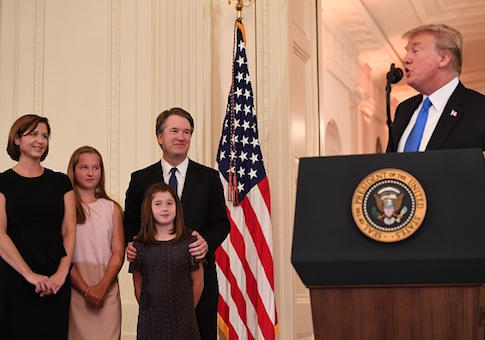President Donald Trump announced Monday night that he would nominate Judge Brett Kavanaugh to replace retiring justice Anthony Kennedy on the nation’s highest court.
In a prime-time announcement from the White House, Trump debuted his second Supreme Court nomination. Kavanaugh is a noted judicial conservative who, as Trump previously promised, is similar to his first pick, Supreme Court justice Neil Gorsuch.
Kavanaugh will now face confirmation hearings before the Senate Judiciary Committee, followed by a vote before the full Senate, assuming he clears the smaller committee. Senate majority leader Mitch McConnell (R., Ky.) has promised the vote will happen by the fall, before midterm elections. Judiciary Committee chairman Chuck Grassley (R., Iowa) said Thursday that the confirmation would move as quickly as possible but may not be before the Court’s new term begins in October.
Kennedy announced his retirement two weeks ago, just hours after the closing of the Court’s term. His departure will become official at the end of July, ending 31 years of service following his appointment by President Ronald Reagan.
Kennedy was generally perceived as the Court’s center, serving as the key swing vote in 5-4 cases that otherwise split the Court’s four liberal and four conservative justices. Trump’s advisers and boosters made clear in the days following Kennedy’s announcement that his replacement would be more in the vein of Trump’s first SCOTUS pick, Gorsuch: an originalist, textualist, and all-around judicial conservative.
Kavanaugh, 53 and a judge on the Court of Appeals for the D.C. Circuit, fits the bill. A former Kennedy clerk, he earned both his B.A. and his J.D. from Yale, and would become the fourth New Haven grad on the Court. He was initially nominated to the D.C. Circuit by President George W. Bush in 2003, although Senate Democrats stalled the nomination for three years so that Kavanaugh did not take his seat until 2006.
Kavanaugh first rose to prominence during the Clinton administration, when he wrote much of the Starr Report and led the investigation into the death of Vince Foster. This work led to an appointment in the Bush White House as senior associate counsel and assistant to the president. American Conservative Union president Matt Schlapp wrote that Kavanaugh, with whom Schlapp worked in the Bush administration, was "someone you can trust and someone you want assistance from when decisions need to be made and the issues are complicated."
Kavanaugh has been called the "intellectual center of the D.C. Circuit’s conservative wing," the author of roughly 270 opinions, concurrences, and dissents in his 12 years on the court. He authored an opinion that declared the Consumer Financial Protection Bureau unconstitutional and that President Trump could fire its director at will (the ruling was subsequently overturned by the full D.C. Circuit en banc).
Kavanaugh’s CFPB ruling signals a suspicion of the constitutional legitimacy of the administrative state, a stance he also communicated in a dissent from denial of petition for rehearing for a lawsuit against the EPA. In the dissent, subsequently cited by Justice Antonin Scalia, Kavanaugh attacked the EPA’s expansive regulations as an extension of the agency’s dangerously unbridled power. With other administrative-state skeptics like Gorsuch already on the Court, a Kavanaugh appointment could mean a trimming of federal regulatory agencies.
Some social conservatives have been skittish about Kavanaugh, tending to prefer Judge Amy Coney Barrett of the Seventh Circuit as a guaranteed fifth vote for social issues like overturning Roe v. Wade. Sarah Pitlyk, a former clerk for Kavanaugh, argued in National Review that these concerns were misplaced, pointing to a series of opinions that social conservatives could get on board with.
The most prominent of these was Kavanaugh’s dissent in Garza v. Hargan, the D.C. Circuit case that pitted the Trump administration against an illegal immigrant teenage mother seeking to abort her child while in government custody. The majority’s ruling was subsequently vacated by the Supreme Court, but not before the abortion had already been carried out. Kavanaugh argued that his colleagues’ ruling had created "a new right for unlawful immigrant minors in U.S. government detention to obtain immediate abortion on demand."
Additionally, Kavanaugh dissented in several important religious liberty rulings. One, Priests for Life v. HHS, saw Kavanaugh siding with a group of priests resisting Obamacare’s contraceptive mandate. Another, a case pitting the Archdiocese of Washington’s Christmas ad against WMATA, saw Kavanaugh siding with allowing the Christ in Christmas.
Some conservative critics have claimed that Kavanaugh helped create a "roadmap" for supporters to save Obamacare in his Seven-Sky v. Holder ruling (although at least one expert has argued this is not the case). And Kavanaugh’s writings on the Clinton impeachment and the definition of obstruction of justice may be taken by Judiciary Democrats as an opportunity to turn his hearing into a sideshow of allegations against the president.
Senate minority leader Chuck Schumer (D., N.Y.) has already signaled his party’s opposition to Kavanaugh. In a series of tweets, Schumer accused Kavanaugh of frequently siding with powerful interests and having passed a "litmus test" of being willing to overturn Roe and oppose Obamacare.
Still, Senate Democrats such as Heidi Heitkamp (N.D.), Joe Manchin (W.Va.), and Joe Donnelly (Ind.)—all of whom voted for Gorsuch and all of whom are facing tough reelection fights in states Trump won in 2016—may break from their caucus and back Kavanaugh.
